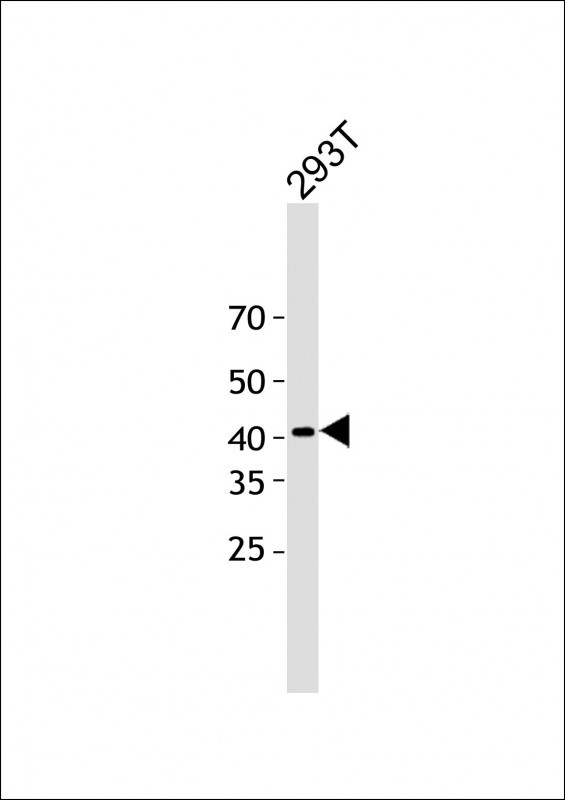M Gpr68 Antibody (Center)
Affinity Purified Rabbit Polyclonal Antibody (Pab)
- 产品详情
- 实验流程
- 背景知识
Application
| WB, E |
|---|---|
| Primary Accession | Q8BFQ3 |
| Other Accession | Q15743, O46685 |
| Reactivity | Mouse |
| Predicted | Bovine, Human |
| Host | Rabbit |
| Clonality | Polyclonal |
| Isotype | Rabbit IgG |
| Calculated MW | 41209 Da |
| Antigen Region | 200-225 aa |
| Gene ID | 238377 |
|---|---|
| Other Names | Ovarian cancer G-protein coupled receptor 1, G-protein coupled receptor 68, Sphingosylphosphorylcholine receptor, Gpr68, Ogr1 |
| Target/Specificity | This Mouse Gpr68 antibody is generated from rabbits immunized with a KLH conjugated synthetic peptide between 200-225 amino acids from the Central region of mouse Gpr68. |
| Dilution | WB~~1:2000 E~~Use at an assay dependent concentration. |
| Format | Purified polyclonal antibody supplied in PBS with 0.05% (V/V) Proclin 300. This antibody is purified through a protein A column, followed by peptide affinity purification. |
| Storage | Maintain refrigerated at 2-8°C for up to 2 weeks. For long term storage store at -20°C in small aliquots to prevent freeze-thaw cycles. |
| Precautions | M Gpr68 Antibody (Center) is for research use only and not for use in diagnostic or therapeutic procedures. |
| Name | Gpr68 {ECO:0000303|PubMed:29677517, ECO:0000312|MGI:MGI:2441763} |
|---|---|
| Function | Proton-sensing G-protein coupled receptor activated by extracellular pH, which is required to monitor pH changes and generate adaptive reactions (By similarity). The receptor is almost silent at pH 7.8 but fully activated at pH 6.8 (By similarity). Ligand binding causes a conformation change that triggers signaling via guanine nucleotide-binding proteins (G proteins) and modulates the activity of downstream effectors, such as phospholipase C (By similarity). GPR68 is mainly coupled to G(q) G proteins and mediates production of diacylglycerol (DAG) and inositol 1,4,5-trisphosphate (IP3) (By similarity). Acts as a key mechanosensor of fluid shear stress and membrane stretch (PubMed:29677517). Expressed in endothelial cells of small-diameter resistance arteries, where it mediates flow-induced dilation in response to shear stress (PubMed:29677517). May represents an osteoblastic pH sensor regulating cell-mediated responses to acidosis in bone (PubMed:18847331). Acts as a regulator of calcium- sensing receptor CASR in a seesaw manner: GPR68-mediated signaling inhibits CASR signaling in response to protons, while CASR inhibits GPR68 in presence of extracellular calcium (PubMed:26261299). Also functions as a metastasis suppressor gene in prostate cancer (PubMed:17728215). |
| Cellular Location | Cell membrane {ECO:0000250|UniProtKB:Q15743}; Multi-pass membrane protein |
| Tissue Location | Expressed in the lung, testis, heart, brain, spleen, thymus, brown fat, small intestine, colon, peripheral blood leukocytes, macrophages, stomach, ovary and white fat but not in the liver, kidney, and skeletal muscle (PubMed:19479052). Expression in the prostate is weak but detectable (PubMed:19479052). Specifically expressed in endothelial cells of small-diameter resistance arteries (PubMed:29677517). |
For Research Use Only. Not For Use In Diagnostic Procedures.
Provided below are standard protocols that you may find useful for product applications.
BACKGROUND
Proton-sensing receptor involved in pH homeostasis. May represents an osteoblastic pH sensor regulating cell-mediated responses to acidosis in bone. Mediates its action by association with G proteins that stimulates inositol phosphate (IP) production or Ca(2+) mobilization. The receptor is almost silent at pH 7.8 but fully activated at pH 6.8. Function also as a metastasis suppressor gene in prostate cancer.
REFERENCES
Carninci P., et al. Science 309:1559-1563(2005).
Vassilatis D.K., et al. Proc. Natl. Acad. Sci. U.S.A. 100:4903-4908(2003).
Singh L.S., et al. J. Natl. Cancer Inst. 99:1313-1327(2007).
Frick K.K., et al. J. Bone Miner. Res. 24:305-313(2009).
Li H., et al. PLoS ONE 4:E5705-E5705(2009).
终于等到您。ABCEPTA(百远生物)抗体产品。
点击下方“我要评价 ”按钮提交您的反馈信息,您的反馈和评价是我们最宝贵的财富之一,
我们将在1-3个工作日内处理您的反馈信息。
如有疑问,联系:0512-88856768 tech-china@abcepta.com.























 癌症的基本特征包括细胞增殖、血管生成、迁移、凋亡逃避机制和细胞永生等。找到癌症发生过程中这些通路的关键标记物和对应的抗体用于检测至关重要。
癌症的基本特征包括细胞增殖、血管生成、迁移、凋亡逃避机制和细胞永生等。找到癌症发生过程中这些通路的关键标记物和对应的抗体用于检测至关重要。 为您推荐一个泛素化位点预测神器——泛素化分析工具,可以为您的蛋白的泛素化位点作出预测和评分。
为您推荐一个泛素化位点预测神器——泛素化分析工具,可以为您的蛋白的泛素化位点作出预测和评分。 细胞自噬受体图形绘图工具为你的蛋白的细胞受体结合位点作出预测和评分,识别结合到自噬通路中的蛋白是非常重要的,便于让我们理解自噬在正常生理、病理过程中的作用,如发育、细胞分化、神经退化性疾病、压力条件下、感染和癌症。
细胞自噬受体图形绘图工具为你的蛋白的细胞受体结合位点作出预测和评分,识别结合到自噬通路中的蛋白是非常重要的,便于让我们理解自噬在正常生理、病理过程中的作用,如发育、细胞分化、神经退化性疾病、压力条件下、感染和癌症。






